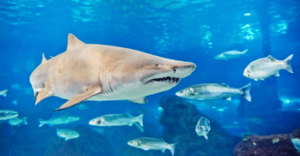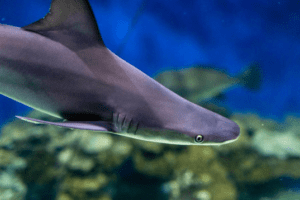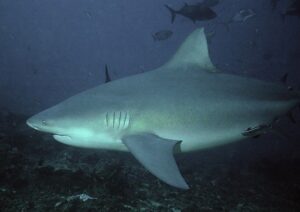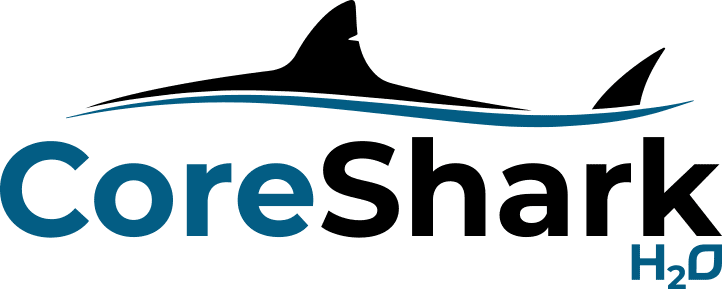Issue 10 | March 2024 | Dear Shark | Sharks in the Bay

Dear Shark,
Why does CoreShark H2O (CSH2O) have the word “Shark” in the organization’s name if CSH2O focuses on educating students about the Bay? I mean, I’ve heard people say that there are sharks in the Chesapeake Bay, but I never believed it. Are there actually sharks in the Bay and if so, is it safe to swim with these “eating machines” lurking about?
Sincerely,
Scared-of-Sharks
Answer provided by: Jen Aiken and Bryan Gomes, CoreShark H2O Environmental Educators
Dear Scared-of-Sharks,
We’re so glad you asked since we get these questions a lot, and we get it! Sharks, like spiders, the dark, and snakes, can evoke a sense of fear in a large percentage of our population. And whether it is rational or irrational, the fear is there. Blame it on historical stories, pop culture (cue the movie Jaws theme music) or even a few isolated events that get massive coverage. Remember the “Summer of the Shark” in 2001? More information on that phenomenon here.
The Discovery Channel launched the very popular “Shark Week” in July of 1988. The name of the first special? “Caged in Fear”. Hard to get around the fear mongering when the word is in the title itself! Since that first year, the week of programming has evolved and has taken a more scientific look at sharks and continues to help educate the public on how important these animals are to our planet.

It is important to remember that sharks play a vital role in our ecosystems – including the Chesapeake Bay! As top predators in the food chain, they are critical to maintaining food web balance. For example, bull sharks enjoy snacking on their “cousins”, cownose rays, which eat mollusks like oysters and clams, which rely on plankton to survive. So instead of the thought of sharks in the Bay being frightening, let’s be excited that we have healthy local waterways that can support all types of flora and fauna.
Yes, sharks are apex predators. Yes, sharks can have sharp teeth. Yes, sharks are a type of cartilaginous fish that have lived on this planet for millions of years. Yes, sharks have simple brains and have a hard time distinguishing a seal from a surfer. And yes, sharks’ preferred diet is NOT humans! We, as a more evolved species, can continue to educate ourselves and learn how to keep ourselves safe when in a shark’s potential space that could be considered a feeding ground; but also know that the chances of a random attack by a shark is absurdly minute. What are the chances compared to other scenarios? Check it out here.

And, yes, there ARE sharks in the Chesapeake Bay! However, it is important to state that there has not been a recorded shark attack in the history of the Chesapeake Bay! These animals are not here for human interaction, they come into the Bay for their normal food of clams, oysters, crabs, fish, rays and turtles. In fact, there are about 12 known species of sharks that live in or visit our Bay. Of those dozen species, there are 5 that are “regulars” and we will touch on those species now.
The two smallest sharks commonly found in the Bay are both in the Dogfish family. Both weigh up to 8 pounds and can be 3-4 feet in length. The Smooth Dogfish is dark brown and has cat-like yellow/gold eyes. The Spiny Dogfish is more light brown to gray, but this species, as the name implies, has some spines around its dorsal fin that can be hazardous to humans if they come in contact with it. Think of a jellyfish tentacle stinging you with its barb. The venom in their spines is extremely painful so use caution if you happen to catch this species on hook and line.
Moving up in size from there is the Sandbar Shark. It can reach a length of 7.5 feet and a weight of 400 pounds. These sharks are light tan to brown and have a short, round, broad snout and lean body. The next size up and another common shark in the Bay is the Sand Tiger Shark. It can be over 500 pounds and nearly 10.5 feet in length. These sharks have two small spineless dorsal fins and brown to copper coloring. They also have pronounced teeth that make them look scarier than they are.

Last, but not least, is the Bull Shark. This species can be upwards of 500 pounds and 11.5 feet in length and yes, this is an aggressive shark that tolerates brackish to fresh water with regularity. Bull sharks can be identified by their flat, round snouts and thick blue/gray colored body.
In addition to the above five, there are seven infrequent and rare shark visitors to the Bay. These include the Basking shark, Bonnethead, Smooth Hammerhead, Atlantic Angel shark, Scalloped Hammerhead, Atlantic Sharpnose and the Dusky shark.
We hope that by learning a bit more about these incredibly misunderstood and unnecessarily feared animals that we’ve sparked an interest to learn more about sharks as well as do your part to protect their habitats – the Bay and Oceans. We can all play a part to protect and preserve our waterways by incorporating conservation behaviors into our daily life; such as reducing the use of single-use plastic, using reusable water bottles and bags, picking up trash, recycling, planting trees, avoiding the use of fertilizers and pesticides, using non-toxic products, conserving water, composting, etc. We can all make a difference!
As far as our organization’s name, there’s a bit of history behind it. Martin Bentz was the CEO and Founder of ClearShark, LLC, a leading cybersecurity and IT solutions provider in Hanover, Maryland. Since 2014, ClearShark H2O was the charitable arm of ClearShark, LLC. However, in 2023, ClearShark, LLC was sold which meant it was time to change our nonprofit’s name. In keeping the acronym CSH2O, the word Core replaced Clear. As far as the word shark, when Martin founded ClearShark, LLC, the word shark evoked a feeling of fierceness, which was fitting for that business. Martin’s wife, Nichole Bentz is the Co-Founder and Executive Director of CoreShark H2O. Prior to focusing her work on CoreShark H2O full-time, Nichole enjoyed a successful career in the IT field at Northrop Grumman.
CoreShark H2O is dedicated to inspiring a passion to protect and preserve Maryland’s waterways through our engaging, hands-on and informative environmental education programs. As we strive to excite students and community groups about the Bay and expand our program offerings, we will be adding a shark program to our repertoire in the near future.
Sincerely, Shark
Have a question…we have the answer! Send us an email on it and what you want to know more about?

